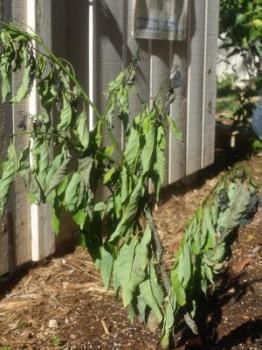May 26, 2018
Why Are My Plants Wilting?
Question:
The newly installed plants in my garden are wilting and looking terrible even though I’m trying my best to keep them well watered. Suggestions?
- Doug H., Deming, NM
Answer:
One thing I like about your question is that it sounds like you haven’t given up. Many people who struggle with gardening get discouraged and think anyone who is successful must have a green thumb. That’s not the case at all. As an Extension Master Gardener volunteer in Albuquerque once said, “The best gardeners have killed the most number of plants.” It’s not a contest…but if it were, I might just win.

I don't mean to imply your plants are headed down that road just yet. Let's look at the possibilities. Although we tend to assume that wilting leaves are a sure sign of too little water, that's not always the case! In fact, leaves wilt for a number of reasons. So if you irrigate the root zone deeply enough and widely enough to be sure the entire root zone is saturated, and then within a day you see sad, droopy leaves, but the root area is still wet, adding more water may make the problem worse.
Leaves may wilt in response to poor drainage, high root temperatures, too much fertilizer, pests and pathogens, spiraling roots that are constricting themselves, and/or compacted soils. Several of those issues are a problem for the plant because of poor oxygen availability in the soil, which can lead to root hypoxia.
Roots need two main things to get established: water and oxygen, not just water. Unfortunately, by overwatering, you may be inadvertently limiting uptake of oxygen. Imagine you have an empty bucket and you add a few shovelfuls of loose soil. Now imagine adding enough water to cover the soil. At first, there's still air in between soil particles, but without proper drainage, as the soil settles and the oxygen bubbles up, the mud at the bottom gets more and more compacted. This is why we want drainage holes in the bottoms of potted plants.
A 2- to 4-inch layer of fibrous, natural mulch, like wood chips, will provide many benefits to the soil and plants. One such benefit is regulating soil temperatures. I'll save discussion of other mulch benefits for a future column.

Fertilizer is not recommended at the time of planting for many plants, especially perennial trees and shrubs that are native or adapted to our area. One reason is that when first set in the ground, we want the roots to grow and establish in their new environment before the top, green part of the plant takes off. Another reason is that many commercial fertilizers exist as a form of salt, and it is easy to accidentally "burn" plants if the dosage applied is too high or if water pools around the roots instead of seeping down into the soil profile. The burning can also happen when using compost as a fertilizer if it hasn't broken down enough. I learned this the hard way with geraniums one sad year when I purchased a bag of composted manure that was way too "hot" to use as the actual planting medium. My new geraniums never stood a chance and died within 24 hours.
Properly used, compost can improve soil health, and is recommended in small amounts for lots of vegetable crops, depending on your soil needs. Getting your soil and homemade compost tested is the best way to remove the guesswork. Visit NMSU Extension Publications - Guide A-114: Test Your Garden Soil and Guide H-110: Backyard Composting.
Marisa Y. Thompson, PhD, is the Extension Horticulture Specialist, in the Department of Extension Plant Sciences at the New Mexico State University Los Lunas Agricultural Science Center, email: desertblooms@nmsu.edu, office: 505-865-7340, ext. 113.
Links:
For more gardening information, visit the NMSU Extension Horticulture page at Desert Blooms and the NMSU Horticulture Publications page.
Send gardening questions to Southwest Yard and Garden - Attn: Dr. Marisa Thompson at desertblooms@nmsu.edu, or at the Desert Blooms Facebook page.
Please copy your County Extension Agent and indicate your county of residence when you submit your question!